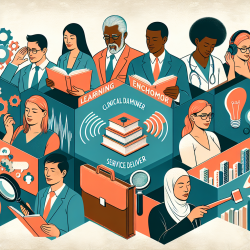Unlocking New Frontiers in Alzheimer's Diagnosis: A Guide for Practitioners
Alzheimer's Disease (AD) is a leading cause of dementia, impacting millions worldwide. As a practitioner, staying abreast of the latest diagnostic methodologies is crucial. Recent advancements in diagnostic approaches, as outlined in the research article "Potential New Approaches for Diagnosis of Alzheimer's Disease and Related Dementias," offer promising avenues for early detection and accurate diagnosis.
Embracing Biomarkers: The Future of Early Detection
Biomarkers have emerged as a cornerstone in the early detection of Alzheimer's. These biological indicators, such as cerebrospinal fluid (CSF) proteins and PET imaging ligands, help identify the pathological hallmarks of AD, namely amyloid plaques and tau tangles. However, the invasiveness and cost of these methods have limited their widespread clinical application.
To address these challenges, the Alzheimer's Precision Medicine Initiative is pioneering the development of blood-based biomarkers. These offer a less invasive and more cost-effective alternative, potentially revolutionizing early AD detection. Practitioners are encouraged to stay informed about these developments and consider incorporating them into their diagnostic toolkit as they become validated and available.
Neuroimaging: Seeing is Believing
Neuroimaging techniques such as MRI and PET scans have transformed our ability to visualize brain changes associated with Alzheimer's. The Alzheimer's Disease Neuroimaging Initiative (ADNI) is a pivotal project that connects researchers to pool and analyze data, enhancing our understanding of AD progression.
Practitioners should consider the integration of neuroimaging into their diagnostic processes, especially for patients presenting with early symptoms of cognitive decline. These tools not only aid in diagnosis but also in monitoring disease progression and evaluating treatment efficacy.
Electroencephalography (EEG): A Non-Invasive Diagnostic Tool
EEG, a technique that records electrical activity in the brain, offers a non-invasive and cost-effective method for diagnosing dementia. Studies have shown that EEG can detect characteristic changes in brain activity associated with Alzheimer's, such as slowing of brain waves and decreased signal complexity.
Incorporating EEG into clinical practice can enhance diagnostic accuracy and provide a comfortable experience for patients. Practitioners should explore the potential of EEG as part of a comprehensive diagnostic approach.
Clinical Decision Support Systems: Enhancing Diagnostic Confidence
Clinical Decision Support Systems (CDSS) are emerging as valuable tools in the diagnostic process. These systems leverage artificial intelligence to analyze complex data sets, providing practitioners with insights that enhance diagnostic accuracy and confidence.
The PredictND tool, for example, has demonstrated high accuracy in differentiating between various types of dementia. Practitioners are encouraged to explore CDSS options and consider their integration into clinical workflows to improve diagnostic outcomes.
Conclusion: A Call to Action
As the landscape of Alzheimer's diagnosis evolves, practitioners must remain proactive in adopting new technologies and methodologies. By embracing advancements in biomarkers, neuroimaging, EEG, and CDSS, practitioners can improve diagnostic accuracy, enhance patient care, and contribute to the ongoing battle against Alzheimer's Disease.
To read the original research paper, please follow this link: Potential New Approaches for Diagnosis of Alzheimer's Disease and Related Dementias.










